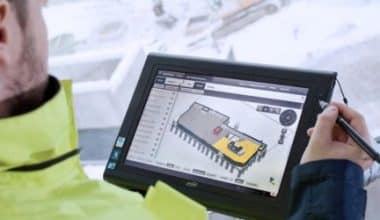Generally, an organization has a legal and moral responsibility to protect its employees from harm on the job, and there are clear guidelines for doing so in every jurisdiction. Furthermore, there is a wealth of evidence demonstrating that sound safety management can cut down on costs and repair any damage to a company’s good name that may have resulted from accidents. An SMS helps identify and mitigate risks in a methodical manner, while also regularly monitoring the efficacy of these controls. Organizations can use safety management systems (SMS) as a framework for managing how it complies with applicable occupational safety and health standards, as required by law. With examples, we explain further, how the safety management systems work below.
Read Also: RISK MANAGEMENT TOOLS: Techniques & All You Need to Know
Safety Management Systems
A safety management system (SMS) is a type of comprehensive, top-down method for minimizing dangers to employees and customers. Methods, techniques, and policies for controlling potential dangers are all part of this framework.
In other words, it’s a very businesslike way of thinking about keeping people safe in an organization. The safety management system is a method that is methodical, explicit, and all-encompassing. A safety management system (SMS), like any other management system, has mechanisms for establishing objectives, developing strategies, and evaluating results.
Basically, integrating a safety management system into a company’s culture is a top priority. The way people execute their work is ingrained in tradition.
However, the SMS’s organizational structure and the resources needed to properly manage occupational health and safety risk are both determined by the breadth of the organization’s operations and, by extension, its risk profile.
Understanding Safety Management Systems (SMS)
By and large, implementing Safety Management Systems (SMS) is the same thing as using a quality management approach to limiting potential dangers. Safety management requires planning, organization, communication, and leadership just like in other management functions and areas.
When creating safety management systems (SMS), the first step is to establish the organization’s safety policy. It specifies the broad guidelines by which the SMS is designed and run. In this initial phase, we lay out the plan to improve workplace safety to an appropriate degree.
When it comes to controlling and reducing danger in the workplace, the next crucial steps are developing a safety strategy and putting that plan into action through safety management systems (SMS). When these controls are complete, they can be evaluated for effectiveness and, if necessary, revised in light of lessons learned from their performance. Deploying safety assurance and evaluation processes allows for constant monitoring of operations and the identification of places where safety can be improved.
Basically, risk and quality management strategies are key to effective safety management systems. In addition, SMS supplies the organizational structure necessary to launch and sustain an effective business-wide safety culture.
When a company implements an SMS, its leaders get a systematic resource for fulfilling the safety obligations imposed on them by their industry’s governing body.
What are the 4 Components of a Safety Management System?
Below are the four fundamental components of safety management systems (SMS);
#1. Safety Policy and Objectives
Organizations should make safety a fundamental value and demonstrate it daily. Top-level administration must set safety goals and work to accomplish them. The leadership team should manage safety like other business areas, and technical managers should ensure safety risk controls are effective.
#2. Safety Risk Management
Safety Risk Management (SRM) is a set of methods for managing safety hazards by authorized employees. It’s used to anticipate and reduce process-level risks.
#3. Safety Assurance
SA is the portion of the safety management systems (SMS) responsible for monitoring operational risk controls. After carefully positioning control measures according to a plan, one should then evaluate both their performance and their efficacy. SA audit, investigate, and report workplace issues.
#4. Safety Promotion
“Safety Promotion” refers to training, knowledge-sharing, and communication programs that help organizations implement safety management systems (SMS). Safety-minded employees will learn about the safety management system, learn from other’s experiences, and be vigilant to potential threats.
What Are the Different Types of Safety Management Systems?
It’s likely that there are as many distinct types of safety management systems as there are different kinds of enterprises.
However, according to the Federal Aviation Administration (FAA), the four components of a safety management system are as follows:
- The safety Policy and Objectives
- Safety Risk Management
- Safety Assurance
- As well as safety Promotion
What Are the 5 Functions of a Safety Management System?
When it comes to implementing a safety management system in a company, there are three necessary conditions that must be met: they are ethical, legal, and financial. Employers have an implied moral obligation to ensure that work activities and the working environment are safe. There are legislative requirements identified in every jurisdiction on how the first requirement is to be achieved. While there is also a substantial body of evidence that shows that effective safety management can reduce the financial exposure and damage to the reputation of an organization as a result of a reduction in the number of accidents.
An efficient safety management system (SMS) in order to solve these three crucial components needs to:
- Define the structure of the organization as it relates to risk management.
- Determine the potential dangers in the workplace and put the appropriate measures in place.
- Establish and maintain clear lines of communication at each and every level of the organization.
- Set up a process to find and deal with any problems of non-conformity or non-compliance.
- Implement a continual improvement method.
What Are the Benefits of a Safety Management System?
A safety management system (SMS) is an organizational instrument that handles risks and accidents more efficiently. Safety management systems (SMSs) help find, report, and deal with hazards in the workplace. They also help make sure that the right resources are used to do these tasks. Also, these technologies help organizations meet local standards, which is important for compliance. Safety management can be difficult, especially when laws vary from one place to another, from one industry sector to another, or from one job to another. A well-designed SMS fits the individual demands of each firm, which include internal safety regulations and legally-required paperwork such as danger assessments. Neglecting safety measures on the other hand can have dire results, and businesses may be held liable even if no employees are physically harmed.
The benefits of safety management systems(SMS) include;
#1. Increasing the Level of Compliance
Companies operating in this sector are subject to strict regulations from governments as a result of the priority placed on workplace health and safety. Due to the fact that rules vary from one jurisdiction to another, compliance can be extremely difficult for large companies. One safety management systems examples of a legal obligation is conducting daily danger assessments at each work site or having a license to operate specific types of machinery. The SMS can handle things like safety audits and document renewals for every employee and every location where they work.
#2. Improve Productivity
A safety management system can automate time-consuming and repetitive components of occupational health and safety. This saves both time and money. The SMS is able to process digital versions of a variety of documents, including safety audits and inspection reports. It eliminates the need for time-consuming processes like printing, scanning, and emailing with attachments.
#3. Reduce Expenditures
By reducing the likelihood of accidents, a safety management system contributes directly to cost reduction and savings. When it comes to the expenses of accidents, every dollar put toward safety can save up to five dollars.
#4. Increasing Performances
A more productive workplace is one that prioritizes employee safety. When an employee comes across a danger, they should have a distinct plan of action to follow if there is an established system in place to identify and manage risks. Nevertheless, when there is insufficient direction or guidance, a single risk can interfere with several tasks. Workers are expected to pay less attention to compliance when it is handled by a safety management system. Workers are not allowed to be reckless as a result of this, but they are exempt from performing many duties that require repetitive motions.
#5. Increases in the Confidence of Employees
When they learn that a company has an effective safety management system, employees report to work feeling more secure in their jobs. Because of this self-assurance, the employees’ productivity will increase because they are aware of the most efficient ways to manage risks and report dangers.
#6. Enhancement of the Organization’s Public Image
When it comes to marketing, having a dependable safety management system is an extra benefit. This is because such a company enjoys a significantly improved public image. This has the potential to bring in clients who likewise place a high value on safety, as well as bright professionals who are looking for the best firms to work for.
Safety Management Systems Examples
It’s a common misconception that developing a safety management system requires the services of experts who charge thousands of dollars an hour. Some corporations’ safety management systems are as complex as databases, while others rely on something as basic as a spreadsheet or paper logs. But your safety management system is the only way to guarantee compliance, pinpoint risks, and address them in your company.
Below are a few examples of safety management systems;
In these, examples, we decide to use A, B, and C as the names of each of these companies, while we explain how and why the safety management systems work for them.
#1. Company A
Company A is a manufacturer with over two decades of experience in the plating market. There is low turnover among the Company’s 200 employees. Due to regular training and years of experience, most of the staff has a good understanding of the potential dangers they face. The company is doing well and has a stable culture with few major shifts in how things are done. Company EHS uses spreadsheets to keep tabs on things like mandatory training and legal requirements. Together with the plant manager, he conducts safety audits and yearly JSAs, and he investigates incidents as they are reported. Management receives a copy of the reports and checks in to make sure all problems have been resolved.
This company’s safety management system is founded on tried and true procedures, seasoned workers, and a committed management team that has been keeping an eye on compliance for years.
#2. Company B
Orthopedic device manufacturing is an emerging market, and Company B is a promising new player in the field. The owner of the company is actively involved in daily operations and, together with his management team, oversees the company’s health and safety initiatives. The company presently employs 100 full-time workers but plans to increase that number by 20% over the next two years. A Company safety committee looks into accidents and keeps an eye on any new procedures or pieces of equipment to make sure any potential dangers are discovered and eliminated. The Company’s own software for managing its safety and health program helps with things like making sure all employees, new and old, get the training they need and keeping track of which jobs present which hazards.
In spite of the fact that the company’s expansion may subject employees to unanticipated risks, those dangers are effectively mitigated by the vigilant monitoring of the safety committee. Software tailored to an organization provides leeway for change as the company develops.
#3. Company C
Company C is an enterprise that has been in business for more than ten years, and it recycles aluminum. They operate round the clock, seven days a week, with a staff of ninety-five people. Supervisors have weekly meetings with management and EHS to address plant operations and safety concerns. If a supervisor identifies a major hazard, they have the power to take immediate action to eliminate it, but they must record the incident and the corrective measures taken. Rather than switching to an electronic system, the Company EHS uses paper forms for incident reporting and tracking, supplemented with OSHA’s online resources for developing and revising written programs. The Company’s workers’ compensation insurance broker is responsible for risk analysis and employee education. Both the EHS and a manager must approve any changes made to mitigate risk.
An SMS can be easily implemented when there is an open dialogue between all parties involved in the safety program and clearly established responsibilities.
In all the above examples, the safety management systems chosen by these companies work for them because they go for one that best suit their workforce and because they are dedicated to controlling health and safety. Once you find an SMS that works for your company, all you have to do is to put it to good use.
Why Do You Need Safety Management System?
No matter what you may have heard or seen, a Safety Management System will help you meet regulations and other requirements better. It will also help your business keep costs down by reducing injuries and occupational illnesses (or both). A Safety Management System gives you all of these benefits.
Conclusion
Safety management systems can help prevents accidents, as well as the human and financial implications of those accidents. When you effectively implement SMS, it can mitigate the numerous expenses relating to accidents, and other hidden costs. A dependable safety management system makes it simpler to comply with regulations and cuts down on the amount of time needed for safety procedures.
The use of safety management systems results in improved workplaces in which employees have a greater sense of being protected while also boosting the public image of their employers. Because consumers view businesses that put an emphasis on employee safety as more responsible, this might give those businesses a marketing edge. You can realize innumerable benefits and make your team safer by introducing a safety management system into your organization and putting it into practice.
Safety Management Systems (SMS) FAQs
What is meant by a safety management system?
The term “Safety Management System” (SMS) refers to an organized set of procedures used across an organization to make sound, risk-based decisions.
What are the basic 7 elements of safety management system?
- Management Leadership and Commitment.
- Training and Orientation
- Evaluations and Continuous Improvement.
- Employee Involvement.
- Hazard Recognition and Evaluation.
- Organizational Communications and System Documentation
- Motivation, Behavior and Attitude.
What is a system management system example?
Some of the examples of safety management systems (SMS) that can help prevent accidents;
- Keeping walkways clear at all times
- Guarding any moving or rotating machine parts
- Fastening heavy or hanging machinery safely and appropriately, and
- Providing workers with adequate safety equipment
Related Articles
- SMS MARKETING: 10 SMS Marketing Examples to Stay in Touch With Customers via Text
- Risk Assessment: Definitive Guide to the Risk Assessment Process
- FEDERAL LAWS THAT PROTECT EMPLOYEES: Why Your Boss Cant Mistreat You
- Top Email Marketing Platforms: 15+ Best Picks For 2023 (Updated!!)
- EVENT MANAGEMENT SYSTEMS (EMS): Top Software Solutions In 2023






